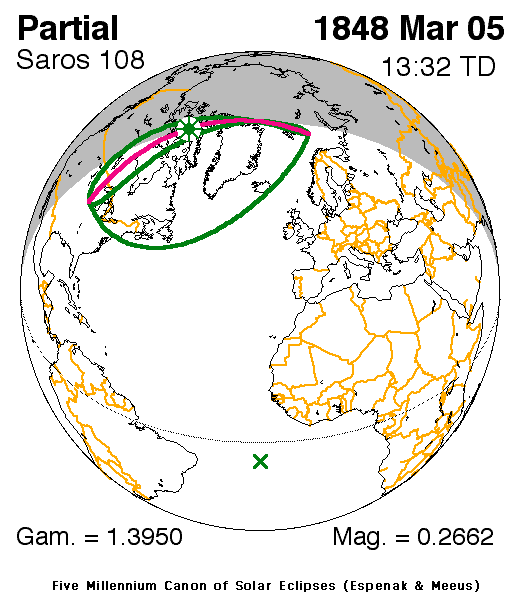|
Solar Eclipse Of April 3, 1848
A partial solar eclipse occurred at the Moon's Lunar node, descending node of orbit between Monday, April 3 and Tuesday, April 4, 1848, with a Magnitude of eclipse, magnitude of 0.5834. A solar eclipse occurs when the Moon passes between Earth and the Sun, thereby totally or partly obscuring the image of the Sun for a viewer on Earth. A partial solar eclipse occurs in the polar regions of the Earth when the center of the Moon's shadow misses the Earth. This eclipse was the second of four partial solar eclipses in 1848, with the others occurring on March 5, August 28 and September 27. Description The eclipse was visible in the Pacific Ocean and included the northeast and northwestern Antarctica especially a part of the west of the Antarctic Peninsula. The eclipse started at sunrise offshore from Antarctica where the Indian and the Pacific Ocean divide and ended at sunset in the peninsula and offshore from Chile. It showed about up to 15-30% obscuration in northern Antarctica with ... [...More Info...] [...Related Items...] OR: [Wikipedia] [Google] [Baidu] |
Solar Eclipse
A solar eclipse occurs when the Moon passes between Earth and the Sun, thereby obscuring the view of the Sun from a small part of Earth, totally or partially. Such an alignment occurs approximately every six months, during the eclipse season in its new moon phase, when the Moon's orbital plane is closest to Ecliptic, the plane of Earth's orbit. In a total eclipse, the disk of the Sun is fully obscured by the Moon. In #Types, partial and annular eclipses, only part of the Sun is obscured. Unlike a lunar eclipse, which may be viewed from anywhere on the night side of Earth, a solar eclipse can only be viewed from a relatively small area of the world. As such, although total solar eclipses occur somewhere on Earth every 18 months on average, they recur at any given place only once every 360 to 410 years. If the Moon were in a perfectly circular orbit and in the same orbital plane as Earth, there would be total solar eclipses once a month, at every new moon. Instead, because the Mo ... [...More Info...] [...Related Items...] OR: [Wikipedia] [Google] [Baidu] |
Solar Eclipse Of May 4, 1837
Solar may refer to: Astronomy * Of or relating to the Sun ** Solar telescope, a special purpose telescope used to observe the Sun ** A device that utilizes solar energy (e.g. "solar panels") ** Solar calendar, a calendar whose dates indicate the position of the Earth on its revolution around the Sun ** Solar eclipse, an eclipse of a sun in which it is obstructed by the moon ** Solar System, the planetary system made up by the Sun and the objects orbiting it * Solar Maximum Mission, a satellite * SOLAR (ISS), an observatory on International Space Station Music * "Solar" (composition), attributed to Miles Davis * ''Solar'' (Red Garland album), 1962 * ''Solar'' (Taeyang album), 2010 * ''Solar'', a 2011 album by Rubik * "Solar", a song by Northlane from ''Mesmer'', 2017 * "Solar", a song by Sault from ''Air'', 2022 * ”Solar”, a song by Stam1na from ''Taival'', 2018 * SOLAR Records, a record label Geography * Solar (Spanish term), a type of urban site * Solar, County ... [...More Info...] [...Related Items...] OR: [Wikipedia] [Google] [Baidu] |
April 1857 Lunar Eclipse
April is the fourth month of the year in the Gregorian and Julian calendars. Its length is 30 days. April is commonly associated with the season of spring in the Northern Hemisphere, and autumn in the Southern Hemisphere, where it is the seasonal equivalent to October in the Northern Hemisphere and vice versa. History The Romans gave this month the Latin name ''Aprilis''"April" in '' Chambers's Encyclopædia''. London: George Newnes, 1961, Vol. 1, p. 497. but the derivation of this name is uncertain. The traditional etymology is from the verb ''aperire'', "to open", in allusion to its being the season when trees and flowers begin to "open", which is supported by comparison with the modern Greek use of άνοιξη (''ánixi'') (opening) for spring. Since some of the Roman months were named in honor of divinities, and as April was sacred to the goddess Venus, her Veneralia being held on the first day, it has been suggested that Aprilis was originally her mo ... [...More Info...] [...Related Items...] OR: [Wikipedia] [Google] [Baidu] |
March 1839 Lunar Eclipse
March is the third month of the year in both the Julian and Gregorian calendars. Its length is 31 days. In the Northern Hemisphere, the meteorological beginning of spring occurs on the first day of March. The March equinox on the 20 or 21 marks the astronomical beginning of spring in the Northern Hemisphere and the beginning of autumn in the Southern Hemisphere, where September is the seasonal equivalent of the Northern Hemisphere's March. History The name of March comes from '' Martius'', the first month of the earliest Roman calendar. It was named after Mars, the Roman god of war, and an ancestor of the Roman people through his sons Romulus and Remus. His month ''Martius'' was the beginning of the season for warfare, and the festivals held in his honor during the month were mirrored by others in October, when the season for these activities came to a close. ''Martius'' remained the first month of the Roman calendar year perhaps as late as 153 BC, and several religious ... [...More Info...] [...Related Items...] OR: [Wikipedia] [Google] [Baidu] |


